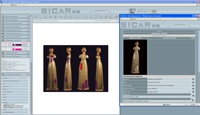Thursday, November 11, 2010 hours 15:00
Design and document restorations. SICaR, a shared network platform: public institutes, territorial government bodies and private entities
 General Direction for the organization of General Affairs, Innovation and the Budget of the Ministry of Cultural Heritage and Cultural Activities in collaboration with Regional Direction of Cultural and Landscape Heritage of Tuscany, Superintendence BAPSAE of Pisa, Superintendence BAPSAE of Lucca, Superintendence of the Archaeological Heritage of Tuscany General Direction for the organization of General Affairs, Innovation and the Budget of the Ministry of Cultural Heritage and Cultural Activities in collaboration with Regional Direction of Cultural and Landscape Heritage of Tuscany, Superintendence BAPSAE of Pisa, Superintendence BAPSAE of Lucca, Superintendence of the Archaeological Heritage of Tuscany
Thursday November 11- from 3:00 p.m. to 6:00 p.m., Sala Giovanni Secco Suardo
Introduction:
Maddalena Ragni, Clara Baracchini, Isabella Lapi, Gian Bruno Rivenni
Moderators:
Francesca Fabiani, Raffaella Grilli
Participants:
Antonia d’Aniello, Carlo Sassetti, Marta Ciafaloni, Valentina Musetti, Emanuela Paribeni, Antonio Alberti, Fulvia Donati, Paolo Liverani, Eliana Siotto.
Round Table- Host and president:
Giorgio Bonsanti
Participants:
Gisella Guasti, Lucrezia Cuniglio, Massimo Marsili, Giorgio Caselli, Don Luca Franceschini.
During the recent last years thanks to the funds co-ordinated by the Direction for the Technology Innovation, currently OAGIP, which is part of the Ministry for Cultural Heritage, it was activated a very important action in the sector of restoration. This action allow restorer to visit a digital platform containing a series of information about the history of a restoration process: SICaR (Network Information System for Restoration Sites).
As a traditional Territorial Information System, SICaR adds to the artwork iconometry representation, a group of different information organised in reserved documents which will facilitate the process of data acquisition of the information acquired during the duration of the restoration sites. The SICaR can support, as a reference system, both raster bases images and vectorial ones; it can import and export in standard format all the vectorial data of the and the alphanumerical data of the restoration reports; it can read hypertexts from the desktop and from any other network database.
The SICaR System works all the data operations (as the deterioration maps or the diagnostic analyses) through an on line updating. All the inserted data can also be shared immediately by lecturers and restorers involved in the restoration process.
The project was created in the context of the Optocantieri action and it was promoted with funds by the Regione Toscana in the year 2003. The SICaR System is currently working thanks to the experimental work made by the Superintendences involved in the project ARTPAST, (www.artpast.org) and by many Italian and foreign museums and institutions in the field of digital architecture.
SICaR at the end of these texts was clearly adopted by the MiBAC which, in a small reserved project, named (REARTE), is going to promote it in all the most national qualified institutions.
3,30 p.m.: An unique instrument for different objectives : experiences and perspectives
Chaired by: Francesca Fabiani, CNR Firenze and Raffaella Grilli, University of Florence
Attending:
Antonia d’Aniello, Superintendence BAPSAE di Lucca, Carlo Sassetti, restorer (RE.DÈ): The use of Sicar for documentation of the restoration process on the vaults of San Martino in Lucca
Marta Ciafaloni, Superintendence BAPSAE di Pisa, Valentina Musetti, architect, Pisa: From the monumental complex to the single element restoration- the Certosa di Calci and the walls of Vicopisano
Emanuela Paribeni, Superintendence of Archaeological Heritage of Tuscany, Antonio Alberti, archaeologist, Pisa: The archaeological heritage in the UNESCO plan for Pisa
Fulvia Donati, University of Pisa/ Paolo Liverani, Musei Vaticani, Eliana Siotto, ISTI CNR Pisa: SiCAR as support to the study of the polychrome ancient marbles
4,30: p.m. Round Table
Introduction by: Giorgio Bonsanti
Attending:
Gisella Guasti, Central National Library of Florence
Lucrezia Cuniglio, Superintendence of Archaeological Heritage of Tuscany
Massimo Marsili, delegate of the Servizio Beni e Attività Culturali, Provincia di Lucca
Giorgio Caselli, Comune di Firenze, Servizio Belle Arti e Fabbrica di Palazzo Vecchio
Don Luca Franceschini, delegate of the CEI Office for Cultural Ecclesiastical Heritage of the Tuscany
The conference focuses on the use of the system in order to explore the artworks construction techniques and the history and methodological information useful to carry out the intervention of restoration. The old techniques but also “the books of secrets”, from the 16th to the 19th century will be explored, together with the archive material as old invoices and other types of written documents. Many construction techniques, as for example gilding and lacquer colour application.
www.arcaz.com
Speakers: Cristina e Leticia Ordoñez
web site |

















